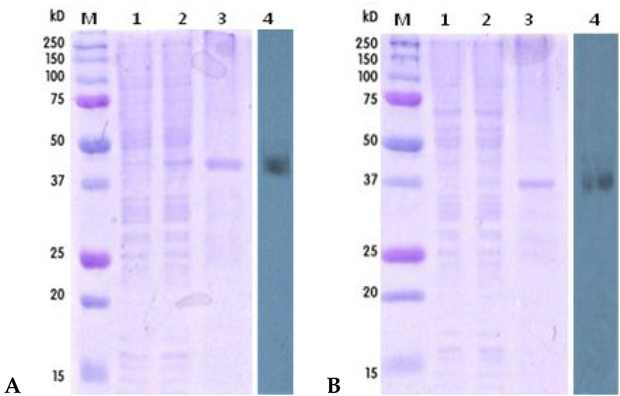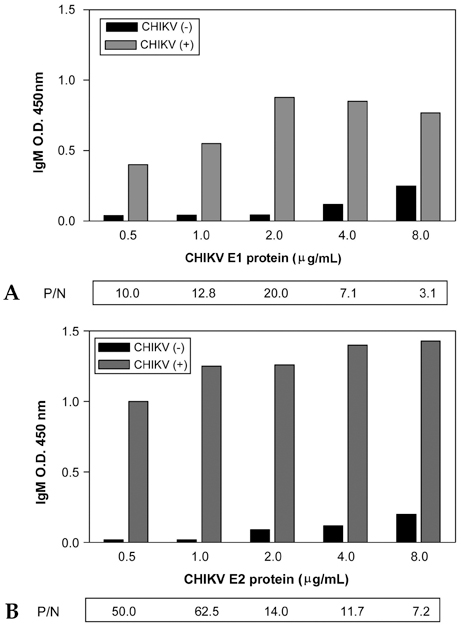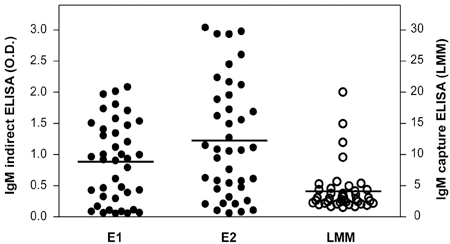Yonsei Med J.
2008 Oct;49(5):828-835. 10.3349/ymj.2008.49.5.828.
Expression and Evaluation of Chikungunya Virus E1 and E2 Envelope Proteins for Serodiagnosis of Chikungunya Virus Infection
- Affiliations
-
- 1Standard Diagnostics Inc., Yongin, Korea. bojeon@yuhs.ac
- 2Department of Microbiology, Ajou University School of Medicine, Suwon, Korea.
- 3Department of Microbiology and Brain Korea 21 Project for Medical Science, Yonsei University College of Medicine, Seoul, Korea.
- KMID: 2158202
- DOI: http://doi.org/10.3349/ymj.2008.49.5.828
Abstract
- PURPOSE
Chikungunya virus (CHIKV) causes endemic or epidemic outbreaks of CHIKV fever, which is a mosquitoe-transmitted viral disease in Africa, India, South-East Asia, and recently Southern Europe. Currently, serological diagnostic tests such as hemagglutination inhibition test (HI test), in-house IgM capture enzyme-linked immunosorbent assays (ELISA), and indirect immunofluorescence test were used for diagnosis of chikungunya fever, which are based on whole virus antigens. MATERIALS AND METHODS: CHIKV E1, and E2 envelope proteins for the CHIKV-specific serodiagnostic reagents for chikungunya fever were expressed in baculovirus expression system. The seroreactivity of recombinant CHIKV E1 and E2 envelope proteins were evaluated using sera panels of patients from Laboratoire Marcel Merieux by indirect IgM capture ELISA. RESULTS: The recombinant CHIKV E1 and E2 envelope protein showed sensitivity of 77.5% and 90%, respectively. The specificities of both CHIKV E1 and E2 envelope proteins were 100%. CONCLUSION: The recombinant CHIKV E1 and E2 envelope proteins could be a useful diagnostic reagent for CHIKV infection.
MeSH Terms
Figure
Reference
-
1. Queyriaux B, Simon F, Grandadam M, Michel R, Tolou H, Boutin JP. Clinical burden of chikungunya virus infection. Lancet Infect Dis. 2008. 8:2–3.
Article2. Diallo M, Thonnon J, Traore-Lamizana M, Fontenille D. Vectors of Chikungunya virus in Senegal: current data and transmission cycles. Am J Trop Med Hyg. 1999. 60:281–286.
Article3. Ross RW. The Newala epidemic. III. The virus: isolation, pathogenic properties and relationship to the epidemic. J Hyg (Lond). 1956. 54:177–191.
Article4. Schuffenecker I, Iteman I, Michault A, Murri S, Frangeul L, Vaney MC, et al. Genome microevolution of chikungunya viruses causing the Indian Ocean outbreak. PLoS Med. 2006. 3:e263.
Article5. Mavalankar D, Shastri P, Raman P. Chikungunya epidemic in India: a major public-health disaster. Lancet Infect Dis. 2007. 7:306–307.
Article6. Sudhakar A, Ramachandran A, Ghosh S, Hasnain SE, Kaufman RJ, Ramaiah KV. Phosphorylation of serine 51 in initiation factor 2 alpha (eIF2 alpha) promotes complex formation between eIF2 alpha(P) and eIF2B and causes inhibition in the guanine nucleotide exchange activity of eIF2B. Biochemistry. 2000. 39:12929–12938.
Article7. Lahariya C, Pradhan SK. Emergence of chikungunya virus in Indian subcontinent after 32 years: A review. J Vector Borne Dis. 2006. 43:151–160.8. Charrel RN, de Lamballerie X, Raoult D. Chikungunya outbreaks-the globalization of vectorborne diseases. N Engl J Med. 2007. 356:769–771.
Article9. Karabatsos N. Antigenic relationships of group A arboviruses by plaque reduction neutralization testing. Am J Trop Med Hyg. 1975. 24:527–532.
Article10. Mourya DT, Yadav P. Vector biology of dengue & chikungunya viruses. Indian J Med Res. 2006. 124:475–480.11. Konishi E, Hotta S. Studies on structural proteins of Chikungunya Virus. I. Separation of three species of proteins and their preliminary characterization. Microbiol Immunol. 1980. 24:419–428.12. Simizu B, Yamamoto K, Hashimoto K, Ogata T. Structural proteins of Chikungunya virus. J Virol. 1984. 51:254–258.13. Kielian M, Rey FA. Virus membrane-fusion proteins: more than one way to make a hairpin. Nat Rev Microbiol. 2006. 4:67–76.
Article14. Brehin AC, Rubrecht L, Navarro-Sanchez ME, Marechal V, Frenkiel MP, Lapalud P, et al. Production and characterization of mouse monoclonal antibodies reactive to Chikungunya envelope E2 glycoprotein. Virology. 2008. 371:185–195.
Article15. Grivard P, Le Roux K, Laurent P, Fianu A, Perrau J, Gigan J, et al. Molecular and serological diagnosis of Chikungunya virus infection. Pathol Biol (Paris). 2007. 55:490–494.16. Nagesha HS, Gould AR, White JR, Lunt RA, Duch CJ. Expression of the major inner capsid protein of the epizootic haemorrhagic disease virus in baculovirus and potential diagnostic use. Virus Res. 1996. 43:163–169.
Article17. Jurutka PW, MacDonald PN, Nakajima S, Hsieh JC, Thompson PD, Whitfield GK, et al. Isolation of baculovirus-expressed human vitamin D receptor: DNA responsive element interactions and phosphorylation of the purified receptor. J Cell Biochem. 2002. 85:435–457.
Article18. Jin YH, Hong SH, Kim K, Shin HJ, Park S. Intracellular antibody fragment against hepatitis B virus X protein does not inhibit viral replication. Yonsei Med J. 2006. 47:721–728.19. Ye YM, Nahm DH, Kim CW, Kim HR, Hong CS, Park CS, et al. Cytokeratin autoantibodies: useful serologic markers for toluene diisocyanate-induced asthma. Yonsei Med J. 2006. 47:773–781.
Article20. Thein S, La Linn M, Aaskov J, Aung MM, Aye M, Zaw A, et al. Development of a simple indirect enzyme-linked immunosorbent assay for the detection of immunoglobulin M antibody in serum from patients following an outbreak of chikungunya virus infection in Yangon, Myanmar. Trans R Soc Trop Med Hyg. 1992. 86:438–442.
Article21. Cho SN. Current issues on molecular and immunological diagnosis of tuberculosis. Yonsei Med J. 2007. 48:347–359.22. Chhabra M, Mittal V, Bhattacharya D, Rana U, Lal S. Chikungunya fever: a re-emerging viral infection. Indian J Med Microbiol. 2008. 26:5–12.23. Kaplan M, Kalkan A, Kuk S, Demirdag K, Ozden M, Kilic SS. Toxocara seroprevalence in schizophrenic patients in Turkey. Yonsei Med J. 2008. 49:224–229.24. Litzba N, Schuffenecker I, Zeller H, Drosten C, Emmerich P, Charrel R, et al. Evaluation of the first commercial chikungunya virus indirect immunofluorescence test. J Virol Methods. 2008. 149:175–179.
Article25. Sharp JS, Nelson S, Brown D, Tomer KB. Structural characterization of the E2 glycoprotein from Sindbis by lysine biotinylation and LC-MS/MS. Virology. 2006. 348:216–223.
Article26. Lanciotti RS, Ludwig ML, Rwaguma EB, Lutwama JJ, Kram TM, Karabatsos N, et al. Emergence of epidemic O'nyong-nyong fever in Uganda after a 35-year absence: genetic characterization of the virus. Virology. 1998. 252:258–268.
Article27. Powers AM, Brault AC, Tesh RB, Weaver SC. Re-emergence of Chikungunya and O'nyong-nyong viruses: evidence for distinct geographical lineages and distant evolutionary relationships. J Gen Virol. 2000. 81:471–479.
Article
- Full Text Links
- Actions
-
Cited
- CITED
-
- Close
- Share
- Similar articles
-
- Western Blot Detection of Human Anti-Chikungunya Virus Antibody with Recombinant Envelope 2 Protein
- The First Imported Case Infected with Chikungunya Virus in Korea
- Chikungunya Virus Infection after Traveling to Surinam, South America
- The first adolescent case infected with chikungunya virus in South Korea
- Expression and Purification of Recombinant Mayaro Virus Envelope Glycoproteins E1 and E2 to Develop a Mayaro Virus Detection System




